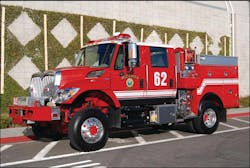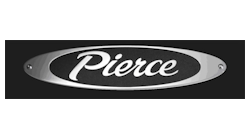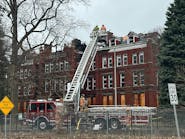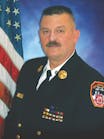For this month's installment of Innovative Rigs on the Street we traveled out to the west coast to visit the Marine Corps Air Station (MCAS) Miramar which is located in San Diego, CA. MCAS Miramar is home to the Third Marine Air Wing, which operates over 500 fixed-wing and rotary aircraft at the airfield. The base encompasses over 25,000 acres of land with a working population of 13,500 with over 5,000 fulltime residents. The fire department protects over 300 buildings with an additional 3,800 residential housing units planned for the future.
The fire department is under the leadership of Chief J. Gregory Magill and operates from two fire stations staffing three engine companies and a rescue squad together with two ALS ambulances. Brush apparatus and a water tender unit are cross staffed by the engine companies in their respective stations. Each engine company is staffed by a captain, engineer and two firefighters who work a 48/72 hour schedule. In addition to protecting the base complex, the department responds on a first alarm basis to locations in San Diego adjacent to the base as well as a large portion of interstate highways with the heavy rescue truck. The department is part of the area Strike Team for wildland fire response throughout the area and anywhere within the State of California.
About The Department
Station One apparatus includes a 2007 Pierce Saber 1,250-gpm pumper assigned as Engine 60, a 2000 Pierce Saber 1,250-gpm pumper for Engine 61 and a 2003 Pierce Saber non-walk-in body unit assigned as Rescue 61. Brush 61 operates a 2002 International/West-Mark Type III wildland unit with a 1994 International 1,200-gallon water tank assigned as Water Tender 61. A 1986 Pierce Arrow four-door cab 1,000-gpm pumper equipped with a 50-foot TeleSqurt serves as a reserve engine for the department. MCAS Miramar's two newest apparatus are assigned to Station Two and include a 2008 Pierce Saber 1,250-gpm pumper for Engine 62. It is equipped with a 500-gallon water tank and a 25-gallon Class A foam tank.
Brush 62 is a 2009 International 7400 4-by-4, four-door cab chassis with bodywork by West-Mark Fire Apparatus of Ceres, California. This apparatus is known as a Type III CDF model 14 brush unit that has pump and roll capability. Due to the large amount of wildland area located on the base, as well as the adjacent land in San Diego, the department trains heavily on wildland exercises during the year. Miramar's two brush units were designed specifically to meet the needs of the department as well as to be compatible with other units that operate on the area strike team. Similarity of chassis and fire pump components are vital when the apparatus could be operating several hundred miles away from local repair outlets and normally utilized service resources.
Brush 62's Specs
The apparatus is built on a 167-inch wheelbase with an overall length of just 24 feet, 1 inch. The unit is powered by an International diesel engine rated at 330-horsepower through an Allison EVS-3000 transmission. The front driving axle is rated at 12,000 pounds with a rear axle rated at 21,000 pounds. A Sauer Sunstrand variable displacement hydraulic pump is mounted in front of the radiator on the front bumper extension and is utilized to power a Darley model JMPH500 two-stage fire pump. This pump is rated for 500-gpm and can provide 60-gpm at 800 psi which would be used for long progressive hose lays from the apparatus.
The apparatus body is fabricated from galvanized steel and is equipped with nine enclosed storage compartments with hinged doors. As with all wildland apparatus, all tools and equipment including hose beds need to be fully enclosed and protected from the elements as well as flying embers and other road hazards. The crosslay and rear hose beds are both protected by heavy flame retardant covers with tension straps as well as aluminum tread plate lift up covers for the rear hose bed area.
The Darley 500-gpm fire pump is equipped with both left and right side 2 1/2-inch inlets as well as a single 4-inch inlet on the left side pump panel. Discharges consist of both 1 1/2-inch and 2 1/2 inch discharges on the left and right sides of the apparatus together with two 1-inch discharges supplying twin booster reels. Each hose reel is equipped with 150 feet of 3/4-inch rubber lined hose. An additional 1 1/2-inch discharge is provided at the front bumper to support walk along operations together with a rear body 1 1/2-inch discharge for a pre-connected handline. Brush 62 carries a 500-gallon water tank that is fabricated of 10 gauge Type 304L stainless steel. A 16-gallon Class A foam tank is utilized to provide foam concentrate for a Foam Pro 2001 foam system which is capable of providing foam to all 1- and 1 1/2-inch discharges on the unit.
In addition to the standard pump panel controls the fire pump and certain discharges can be operated from within the cab in easy reach of the engineer for pump and roll operations when required. The interior of the cab is provided with seating for four personnel with high back seats as well as protective fire curtains which can be deployed to protect the windshield and side cab windows from heat and flame in the event of a burn over. A Firecom headset system is provided for each of the seating positions in the cab.
Lighting and Safety Features
Emergency warning lights consist of a Code 3 model 1069 light bar on the cab roof together with Code 3 LED warning lights around the perimeter of the apparatus. Scene lighting is provided on both sides and the rear body as well as a remote controlled Go Light on the cab roof.
The cab steps, pump panel running boards and rear step area all incorporate aggressive non-slip stepping surfaces together with fixed body steps and handrails to enhance crew safety.
Brush 62 was well designed and constructed to meet the needs of the Miramar MCAS Fire Department in addition to providing a good accounting of itself at any major wildland incident.
I would like to thank Chief Greg Magill and the members of the Miramar MCAS Fire Department who assisted with technical information and photographs of their department's apparatus. A special thank you to Jonathan Holmes of West-Mark Fire Apparatus for his assistance.
TOM SHAND is a 37-year veteran of the fire service having served with departments in Maryland, Pennsylvania and New York. He has worked in the fire apparatus industry since 1985, including 15 years with Saulsbury Fire Apparatus. He is a contributing editor to Fire Apparatus Journal and Firehouse Magazine and works with Mike Wilbur at Emergency Vehicle Response. He co-hosts the Apparatus Architects podcast with Wilbur, based on their column in Firehouse Magazine.







